
PY 131 Chapter 28: Reflection and Refraction
Reflection and Refraction
Light is a wave so it does all the same things that other waves do.
It reflects, refracts, diffracts and can interfere with other light waves.
Reflection
At any point on a surface we can define a normal.
The angle between the incoming light ray and the normal is called the angle of incidence.
The angle between the outgoing light ray and the normal is called the angle of reflection.
The Law of Reflection is
the angle of incidence is equal to the angle of reflection

When the light from an object is reflected from a flat reflecting surface (a plane mirror), the reflected light appears to be emitted from an image of the object that is behind the mirror.
The image of the object is located as far behind the mirror as the real object is in front of it.
The image of the object is the same size as the object
Since the light does not actually come from the image in a mirror, the image is called a virtual image.

If the mirror is curved, these two properties of the image are no longer true.
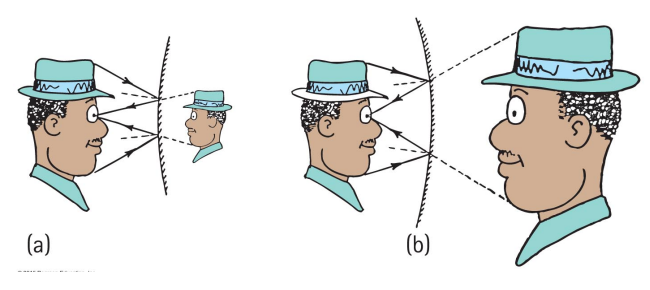
If the mirror is convex, the image is smaller and closer to the mirror than the object
If the mirror is concave, the image is larger and farther away from the mirror than the object.
If the surface is rough then the normals to the surface point in many different directions.
If the wavelength of the light is less than the height of the irregularities, the rays of light are reflected in different directions.
liquids are usually good mirrors because the irregularities of the surface are the height of an atom or two.
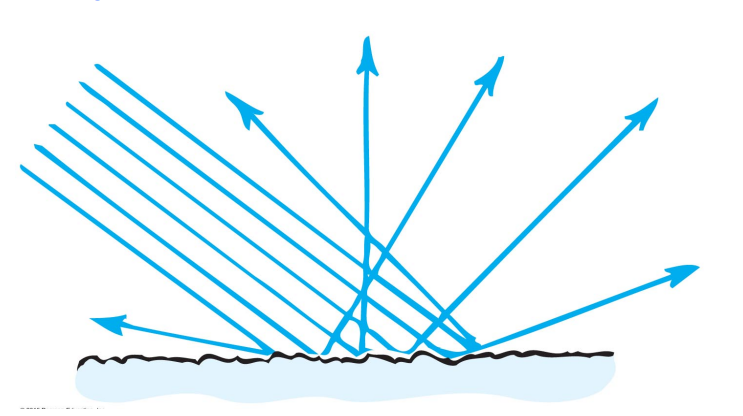
Refraction
The speed of light is different in different materials.
In addition to the change of speed, the direction the light propagates can be changed.
Both effects are called refraction.
Again at the point where the ray meets the boundary between the two materials we can construct a normal
Consider a ray of light propagating from one material into another material
At the point where the ray meets the boundary between the two materials we can construct a normal.
The angle of incidence is defined as before
The angle of refraction is the angle between the normal the direction of the ray in the new material.
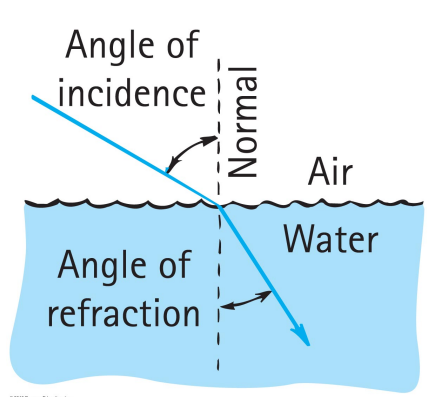
If the index of refraction in the first material is n1 and the index of refraction if the second is n2, the Law of Refraction is
n_1 sin(θ_1)=n_2 sin (θ2)
If n_2 > n_1 then the angle of refraction must be smaller than the angle of incidence.
If n_2 < n_1 then the angle of refraction must be greater than the angle of incidence.

Due to refraction, objects in water appear to be closer to the surface than they really are.
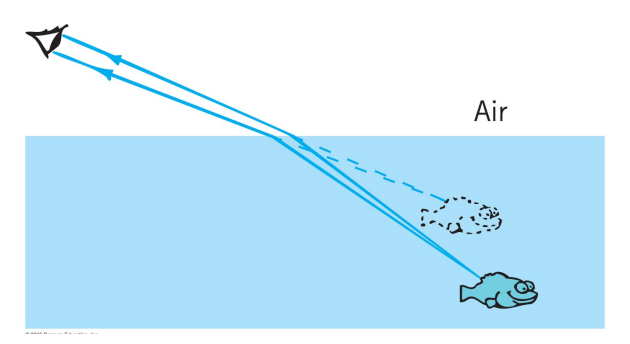
Mirages
Refraction can occur in a single material if the density changes.
If the change in density is gradual then the trajectory of the light ray changes smoothly i.e. no sudden jumps.
For example:
as light propagates from denser air into less dense air it curves away from the vertical direction,
as light propagates from less dense air into more dense air it curves towards the vertical direction,
This bending can lead to mirages.
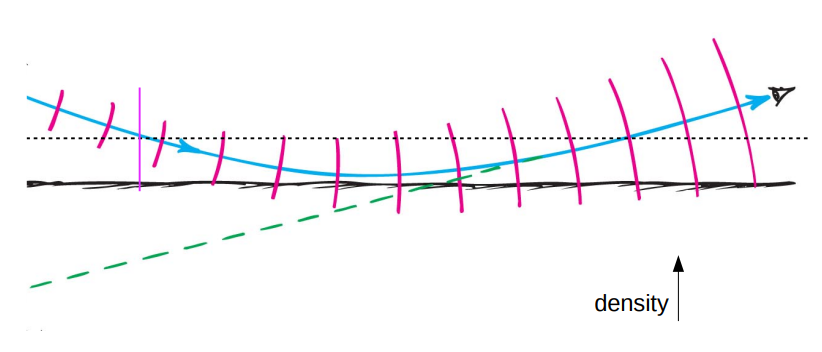
Light that was traveling towards the ground can be turned around and appear to be coming from the ground.
If the warm air is above cool air then a different type of mirage is possible.
Now light that was propagating upwards can be turned around and can appear to be coming from above
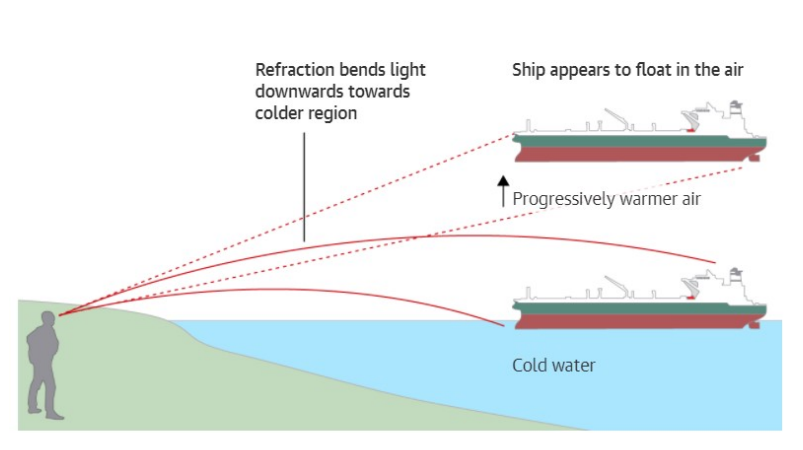
The density of air decreases with height.
This decrease in density leads to the refraction of light which is most noticeable for sources which are close to the horizon.
Sources which are actually below the horizon can appear to be above the horizon.
the Sun actually drops below the horizon several minutes before it appears to set
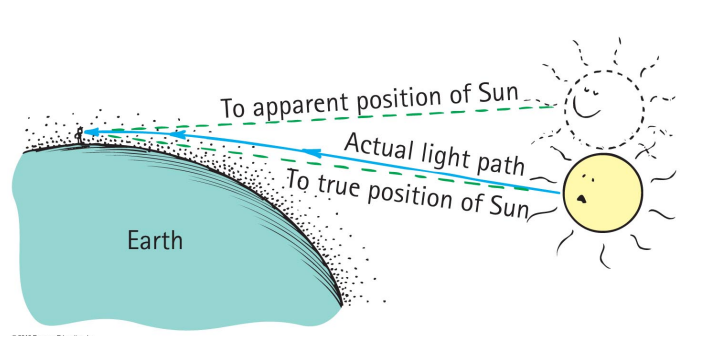
Total Internal Reflection
If light traveling through a material meets a boundary with another material with a lower index of refraction, it is possible that the light does not enter the second material.
Instead the light is reflected at the boundary, it does not refract.
This phenomenon is called Total Internal Reflection

The critical angle is that angle of incidence such that the angle of refraction is 90 degrees.
The critical angle depends upon the indicii of refraction of the two material.
sin(θ_c )= n_2 / n_1
For air and water the critical angle is 48 degrees
For glass and air the critical angle is around 43 degrees.
Using the effect of total internal reflection, a piece of shaped glass acts like mirror.

Fiber optic cables work on the same principle.
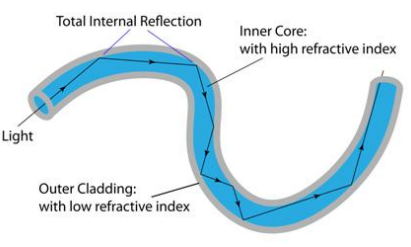
The light cannot escape the fiber because it always meets the glass/air boundary at an angle of incidence greater than the critical angle, no matter the shape of the fiber
Dispersion
The speed of light in some materials is different for different frequencies of light.
This means the index of refraction depends upon the frequency which means the angle of refraction depends on frequency.
This effect is called dispersion.
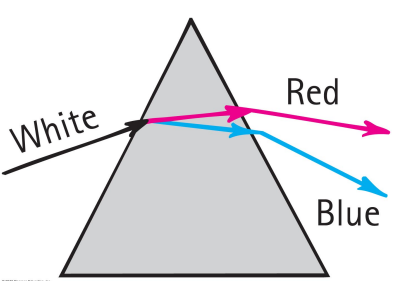
Rainbows are a consequence of the dispersive refraction of light by water droplets.
Blue/violet light has a higher speed in water than red.
The different colors emerge from a droplet propagating at different angles.
An observer on the ground can’t see both rays from a single droplet.
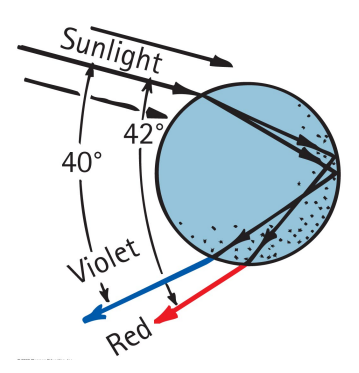
Instead what an observer sees are rays from different droplets.
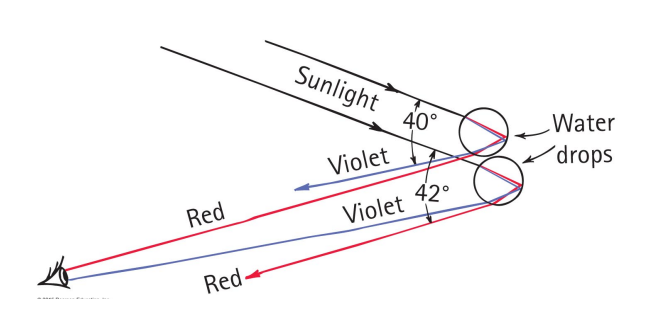
The angle between the red and violet rays which enter the eye is 2 degrees.
The red arc is on the outside, the violet on the inside
The arc shape is the edge of a cone whose axis is the line that joins you to the Sun.
everyone sees a personal rainbow
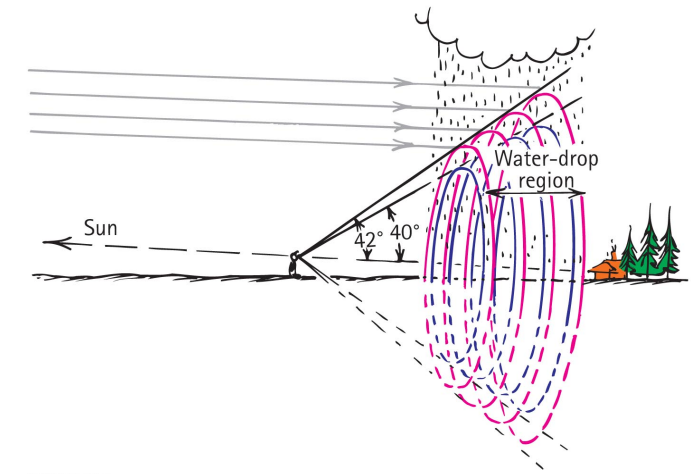
Pilots get to see the entire circle.
Sometimes a second bow can be seen due to two internal reflections within the droplets.

The width of this bow is about 3 degrees and the order of the colors is reversed.
The secondary bow is fainter because less light is reflected twice than the main bow where it is reflected once.
Lenses
A lens is a shaped piece of a transparent material that disperses or focuses light by means of refraction.
For visible light the lenses we commonly encounter are made of glass or clear plastic.
At other frequencies, lenses can be made from other materials.

The two basic types of lens are the convex lens which causes light rays to converge, and the concave lens which causes light rays to diverge.
In both cases the surfaces of the lenses are frequently sections of the surface of a sphere.
The main use of lenses is to make images:
Examples of images are seen on a cinema screen, through telescopes and glasses, and on the retinas of your eyes
An image is not what you see on a TV, computer monitor or phone screen, those are sources of light
Without a lens there would be no image: a lens focuses light so that (ideally) the light at a particular point on the image can only come from one point on the source.
An image is a mapping; each point on an image corresponds to a point on the object being viewed.
the source may be three dimensional but the image is two-dimensional.
Images are said to come in two types: real and virtual.
a real image is formed at the convergence of light rays
a virtual image is formed at the location where divergent light rays appear to diverge from.
in practical terms, a real image can be seen on a screen, a virtual image cannot.
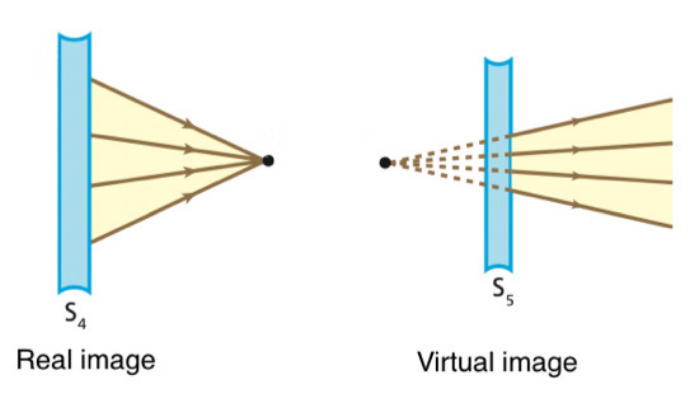

There’s a lot of technical terms associated with lenses
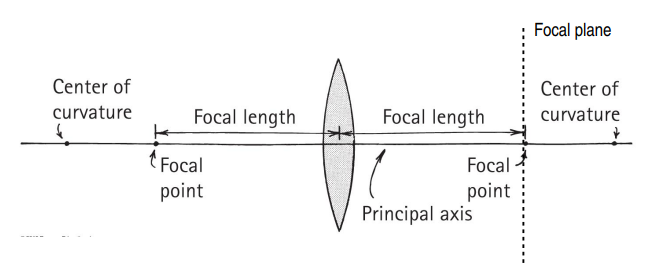
Principal (Optical) axis: the line joining the centers of curvature of the two lens surfaces
Focal point: the point at which all the light rays come together
Focal length: the distance between the center of the lens and either focal point
Focal plane: the plane passing through the focus and perpendicular to the optical axis
Lens Defects
No lens can produce a perfect image.
Lenses have defects that distort the image in some way.
A distortion of an image is called an aberration.
There are a number of different aberrations:
spherical aberration,
chromatic aberration,
coma,
astigmatism,
For a spherical lens or mirror, the focus of rays parallel to the optical axis depend upon their distance from the optical axis.
this is called spherical aberration
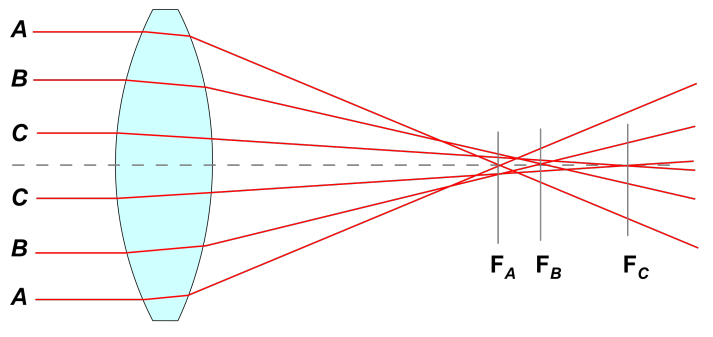
The different focii will lead to blurring of the image on the chosen focal plane.
It is possible to build aspheric lenses that don't suffer this effect but they are much harder (expensive) to manufacture.
The index of refraction for a material is often different for different colors of light.
This means the focal length of a lens made from that material will be different for different colors.
This defect is called chromatic aberration.
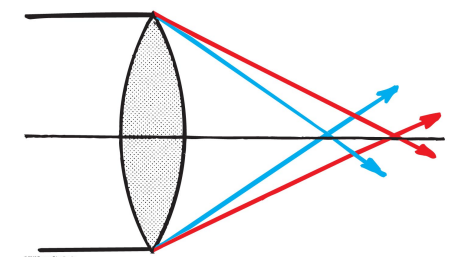
There is no place to put a screen so that all the different colors are in focus at the same time.
PY 131 Chapter 28: Reflection and Refraction
Reflection and Refraction
Light is a wave so it does all the same things that other waves do.
It reflects, refracts, diffracts and can interfere with other light waves.
Reflection
At any point on a surface we can define a normal.
The angle between the incoming light ray and the normal is called the angle of incidence.
The angle between the outgoing light ray and the normal is called the angle of reflection.
The Law of Reflection is
the angle of incidence is equal to the angle of reflection

When the light from an object is reflected from a flat reflecting surface (a plane mirror), the reflected light appears to be emitted from an image of the object that is behind the mirror.
The image of the object is located as far behind the mirror as the real object is in front of it.
The image of the object is the same size as the object
Since the light does not actually come from the image in a mirror, the image is called a virtual image.

If the mirror is curved, these two properties of the image are no longer true.

If the mirror is convex, the image is smaller and closer to the mirror than the object
If the mirror is concave, the image is larger and farther away from the mirror than the object.
If the surface is rough then the normals to the surface point in many different directions.
If the wavelength of the light is less than the height of the irregularities, the rays of light are reflected in different directions.
liquids are usually good mirrors because the irregularities of the surface are the height of an atom or two.

Refraction
The speed of light is different in different materials.
In addition to the change of speed, the direction the light propagates can be changed.
Both effects are called refraction.
Again at the point where the ray meets the boundary between the two materials we can construct a normal
Consider a ray of light propagating from one material into another material
At the point where the ray meets the boundary between the two materials we can construct a normal.
The angle of incidence is defined as before
The angle of refraction is the angle between the normal the direction of the ray in the new material.

If the index of refraction in the first material is n1 and the index of refraction if the second is n2, the Law of Refraction is
n_1 sin(θ_1)=n_2 sin (θ2)
If n_2 > n_1 then the angle of refraction must be smaller than the angle of incidence.
If n_2 < n_1 then the angle of refraction must be greater than the angle of incidence.

Due to refraction, objects in water appear to be closer to the surface than they really are.

Mirages
Refraction can occur in a single material if the density changes.
If the change in density is gradual then the trajectory of the light ray changes smoothly i.e. no sudden jumps.
For example:
as light propagates from denser air into less dense air it curves away from the vertical direction,
as light propagates from less dense air into more dense air it curves towards the vertical direction,
This bending can lead to mirages.

Light that was traveling towards the ground can be turned around and appear to be coming from the ground.
If the warm air is above cool air then a different type of mirage is possible.
Now light that was propagating upwards can be turned around and can appear to be coming from above

The density of air decreases with height.
This decrease in density leads to the refraction of light which is most noticeable for sources which are close to the horizon.
Sources which are actually below the horizon can appear to be above the horizon.
the Sun actually drops below the horizon several minutes before it appears to set

Total Internal Reflection
If light traveling through a material meets a boundary with another material with a lower index of refraction, it is possible that the light does not enter the second material.
Instead the light is reflected at the boundary, it does not refract.
This phenomenon is called Total Internal Reflection

The critical angle is that angle of incidence such that the angle of refraction is 90 degrees.
The critical angle depends upon the indicii of refraction of the two material.
sin(θ_c )= n_2 / n_1
For air and water the critical angle is 48 degrees
For glass and air the critical angle is around 43 degrees.
Using the effect of total internal reflection, a piece of shaped glass acts like mirror.

Fiber optic cables work on the same principle.

The light cannot escape the fiber because it always meets the glass/air boundary at an angle of incidence greater than the critical angle, no matter the shape of the fiber
Dispersion
The speed of light in some materials is different for different frequencies of light.
This means the index of refraction depends upon the frequency which means the angle of refraction depends on frequency.
This effect is called dispersion.

Rainbows are a consequence of the dispersive refraction of light by water droplets.
Blue/violet light has a higher speed in water than red.
The different colors emerge from a droplet propagating at different angles.
An observer on the ground can’t see both rays from a single droplet.

Instead what an observer sees are rays from different droplets.

The angle between the red and violet rays which enter the eye is 2 degrees.
The red arc is on the outside, the violet on the inside
The arc shape is the edge of a cone whose axis is the line that joins you to the Sun.
everyone sees a personal rainbow

Pilots get to see the entire circle.
Sometimes a second bow can be seen due to two internal reflections within the droplets.

The width of this bow is about 3 degrees and the order of the colors is reversed.
The secondary bow is fainter because less light is reflected twice than the main bow where it is reflected once.
Lenses
A lens is a shaped piece of a transparent material that disperses or focuses light by means of refraction.
For visible light the lenses we commonly encounter are made of glass or clear plastic.
At other frequencies, lenses can be made from other materials.

The two basic types of lens are the convex lens which causes light rays to converge, and the concave lens which causes light rays to diverge.
In both cases the surfaces of the lenses are frequently sections of the surface of a sphere.
The main use of lenses is to make images:
Examples of images are seen on a cinema screen, through telescopes and glasses, and on the retinas of your eyes
An image is not what you see on a TV, computer monitor or phone screen, those are sources of light
Without a lens there would be no image: a lens focuses light so that (ideally) the light at a particular point on the image can only come from one point on the source.
An image is a mapping; each point on an image corresponds to a point on the object being viewed.
the source may be three dimensional but the image is two-dimensional.
Images are said to come in two types: real and virtual.
a real image is formed at the convergence of light rays
a virtual image is formed at the location where divergent light rays appear to diverge from.
in practical terms, a real image can be seen on a screen, a virtual image cannot.


There’s a lot of technical terms associated with lenses

Principal (Optical) axis: the line joining the centers of curvature of the two lens surfaces
Focal point: the point at which all the light rays come together
Focal length: the distance between the center of the lens and either focal point
Focal plane: the plane passing through the focus and perpendicular to the optical axis
Lens Defects
No lens can produce a perfect image.
Lenses have defects that distort the image in some way.
A distortion of an image is called an aberration.
There are a number of different aberrations:
spherical aberration,
chromatic aberration,
coma,
astigmatism,
For a spherical lens or mirror, the focus of rays parallel to the optical axis depend upon their distance from the optical axis.
this is called spherical aberration

The different focii will lead to blurring of the image on the chosen focal plane.
It is possible to build aspheric lenses that don't suffer this effect but they are much harder (expensive) to manufacture.
The index of refraction for a material is often different for different colors of light.
This means the focal length of a lens made from that material will be different for different colors.
This defect is called chromatic aberration.

There is no place to put a screen so that all the different colors are in focus at the same time.
 Knowt
Knowt
